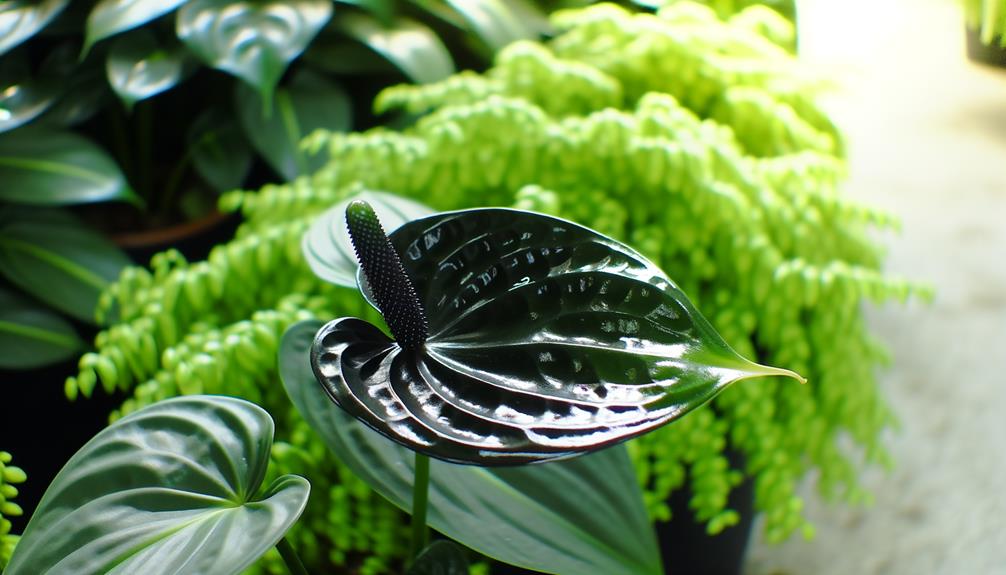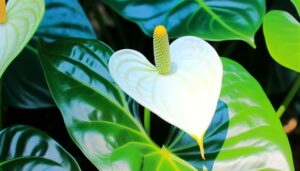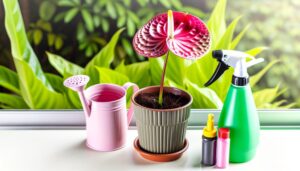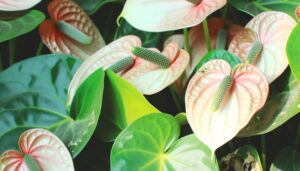Caring for the Rare Black Anthurium
To care for your rare Black Anthurium, place it in bright, indirect light for 8-10 hours daily, ideally near a north or east-facing window, using sheer curtains to diffuse harsh rays. Maintain moist but not waterlogged soil; water when the top inch is dry, using filtered or rainwater.
Use a well-draining mix of orchid bark, perlite, and peat moss. Keep temperatures between 70-85°F and humidity at 60-80%.
Prune dead foliage every 4-6 weeks, and manage pests with insecticidal soap or neem oil. For propagation, utilize division or stem cuttings.
There are several more key elements to ponder for best growth.

Key Takeaways
- Place in bright, indirect light for 8-10 hours daily to boost growth.
- Water when the top inch of soil is dry, using filtered or rainwater.
- Maintain a well-draining soil mix of orchid bark, perlite, and peat moss.
- Keep the temperature between 70-85°F and humidity around 70-80%.
- Regularly prune dead foliage and treat common pests with neem oil or insecticidal soap.
Ideal Lighting Conditions
To maximize growth for the rare Black Anthurium, place it in an environment where it receives bright, indirect light for approximately 8-10 hours a day. Positioning it near a north or east-facing window is ideal, as it avoids direct sun that can scorch the foliage. The Black Anthurium's chlorophyll production is enhanced under these conditions, improving photosynthesis and promoting robust growth. Utilize sheer curtains to diffuse harsh rays if necessary.
Watering Routine
Proper hydration is essential for the Black Anthurium, requiring a consistent watering routine that maintains moist but not waterlogged soil. Water the plant when the top inch of soil feels dry to the touch.
Use filtered or rainwater to avoid mineral buildup, which can affect root health. Pour water slowly until you see it draining from the bottom, ensuring thorough hydration of the root system. Avoid letting the plant sit in excess water, as anthuriums are susceptible to root rot.
Monitor the humidity levels, aiming for 60-80%, as these tropical plants thrive in humid environments. Mist the leaves occasionally to replicate their natural habitat, but do so in the morning to allow the foliage to dry by evening, preventing fungal issues.
Soil Preferences
Ever wondered what type of soil best supports the unique needs of a Black Anthurium?
You'll need a well-draining, aerated mix to mimic its native tropical habitat. Combine equal parts orchid bark, perlite, and peat moss. The orchid bark offers essential aeration, while perlite enhances drainage, preventing root rot. Peat moss retains necessary moisture without waterlogging the roots.
Your Black Anthurium thrives when its roots can breathe, absorbing oxygen efficiently to stimulate growth and vibrant blooms. Guarantee the pH level stays between 5.5 and 6.5, as slightly acidic conditions optimize nutrient uptake.
Regularly check the soil's consistency—compactness can stifle root health. This bespoke blend guarantees your plant's physiological needs are met, fostering robust development.
Temperature Requirements
Maintaining the best temperature range of 70-85°F is essential for the Black Anthurium's physiological functions.
You should monitor seasonal temperature changes, ensuring they don't drop below 60°F or exceed 90°F, to prevent thermal stress.
Watch for signs of temperature stress such as leaf wilting or discoloration to adjust environmental conditions promptly.
Ideal Temperature Range
For best growth and health, the Black Anthurium thrives in a temperature range between 65°F and 80°F, mimicking its native tropical environment. Maintain this range consistently; fluctuations can stress the plant, leading to inhibited growth or leaf discoloration. Use a reliable thermometer to monitor ambient conditions closely.
Avoid placing the plant near drafts or heating vents, as sudden temperature changes can disrupt its metabolic processes. Keep the humidity high, around 60-80%, to support ideal transpiration and nutrient uptake. If indoor conditions are dry, consider using a humidifier.
Ensuring stable temperatures will help your Black Anthurium efficiently perform photosynthesis, respiration, and other critical physiological functions, resulting in lush, vibrant foliage and robust health.
Seasonal Temperature Changes
While maintaining a stable temperature is essential, it's equally important to adjust care practices for your Black Anthurium during seasonal temperature changes to guarantee its continued health and growth. Your plant thrives in a temperature range of 65-80°F (18-27°C).
Here's how to manage:
- Winter: Reduce watering frequency and make sure the temperature doesn't drop below 60°F (15°C) to prevent dormancy.
- Spring: Gradually increase watering as the temperature rises. Aim for a stable 70-75°F (21-24°C).
- Summer: Maintain humidity levels and make sure temperatures don't exceed 85°F (29°C) to avoid stress.
- Autumn: Begin reducing water and monitor for cooler nights, keeping temperatures above 65°F (18°C).
Careful adjustments guarantee your Black Anthurium remains strong year-round.
Temperature Stress Signs
Recognizing temperature stress in your Black Anthurium is important, as signs like leaf discoloration, wilting, and stunted growth indicate the plant is outside its best temperature range of 65-80°F (18-27°C).
You should monitor leaf appearance closely; chlorosis suggests cold stress, while necrosis hints at heat stress. Make sure you're using a reliable thermometer to maintain consistent ambient conditions.
Position your plant away from drafty windows, heaters, or air conditioners. If you notice drooping leaves, check for rapid temperature fluctuations. Correct these by adjusting your heating or cooling appliances.
Humidity Levels
You'll need to sustain a humidity level of 60-80% to support the Black Anthurium's tropical physiology.
To boost humidity, utilize methods such as misting, using a humidity tray, or operating a humidifier nearby.
Monitoring with a hygrometer ensures you're providing the best environment for healthy growth.
Ideal Humidity Range
Maintaining a humidity level between 70% and 80% is vital for the best growth and health of the rare Black Anthurium. This tropical plant thrives in high humidity environments, mimicking its native habitat. You should monitor the ambient humidity closely using a hygrometer. Here's why this range is essential:
- Stomatal Function: High humidity guarantees stomata remain open for optimal gas exchange and photosynthesis.
- Transpiration Rate: Proper humidity reduces excessive water loss, preventing dehydration.
- Nutrient Uptake: Adequate moisture aids in the efficient uptake of nutrients through the roots.
- Disease Prevention: Keeping humidity within this range helps minimize the risk of fungal and bacterial infections.
Increasing Humidity Methods
To increase humidity levels for your Black Anthurium, consider using a combination of methods such as misting, humidifiers, and pebble trays.
Misting provides immediate but temporary moisture. Use distilled water to avoid mineral buildup on leaves, misting in the morning to allow droplets to dry.
Humidifiers can maintain consistent humidity; place one near your plant, setting it to 60-80% humidity.
For a pebble tray, fill a shallow tray with pebbles and water, ensuring the pot's base isn't submerged, which allows evaporation to increase ambient humidity.
Black Anthuriums thrive in high humidity due to their tropical origins, which facilitate efficient stomatal function and transpiration, ensuring the best photosynthesis and nutrient uptake. Implement these strategies for a lush, vibrant plant.
Fertilization Tips
Proper fertilization is crucial for the optimal growth and vivid coloration of the rare black Anthurium. You'll need to guarantee your plant receives the right nutrients at the correct intervals. Follow these detailed tips:
- Use a balanced, water-soluble fertilizer: Opt for a 20-20-20 NPK formula, diluted to half strength.
- Fertilize during the growing season: Apply the fertilizer every 6-8 weeks from spring to early autumn.
- Monitor soil pH: Maintain the pH between 5.5 and 6.5, as black Anthuriums prefer slightly acidic conditions.
- Avoid over-fertilization: Excessive nutrients can cause root burn and hinder growth; flush the soil with water periodically to prevent buildup.
Pruning and Maintenance
Regular pruning is essential to promote healthy growth and prevent disease in your black Anthurium. Start by sterilizing your pruning shears with isopropyl alcohol. Carefully examine your plant for any yellowing leaves or spent blooms, and remove them by cutting at the base of the stem. This encourages better air circulation and reduces the risk of pathogens.
Maintain a pruning schedule every 4-6 weeks, focusing on removing any damaged or dead foliage. Be gentle with new growth; it's more susceptible to injury.
| Step | Action | Frequency |
|---|---|---|
| Sterilization | Clean pruning tools | Before each use |
| Inspection | Check for dead foliage | Every 4-6 weeks |
| Cutting | Remove yellow leaves | As needed |
| Bloom Removal | Cut spent blooms | As needed |
| New Growth Care | Handle with care | Continuous |
Pruning also diverts energy to healthier parts, enhancing blooms.
Pest Management
Effective pest management for your black Anthurium involves identifying common pests such as aphids, spider mites, and mealybugs, and employing targeted treatments to control infestations. Recognize signs of distress: yellowing leaves, webbing, and sticky residue. Inspect the undersides of leaves and stems regularly.
- Aphids: Remove by spraying the plant with a mixture of water and insecticidal soap. Rinse thoroughly.
- Spider Mites: Increase humidity around the plant and use neem oil to disrupt their lifecycle.
- Mealybugs: Dab affected areas with rubbing alcohol using a cotton swab.
- Preventative Measures: Maintain ideal humidity levels and avoid over-fertilization, which can attract pests.
Propagation Methods
To propagate your black Anthurium, you'll rely primarily on division or stem cuttings to guarantee successful growth and genetic consistency.
For division, gently uproot the plant and separate the rhizomes, verifying each section has at least one healthy root and shoot. Replant these divisions in well-draining soil, maintaining humidity to encourage root establishment.
For stem cuttings, select a healthy stem with at least two nodes. Using sterilized scissors, make a clean cut below a node. Submerge the cut end in rooting hormone and plant it in a moist, well-aerated medium. Keep the cutting in indirect light and maintain high humidity to promote rooting.
Both methods secure robust growth and preserve the unique characteristics of your black Anthurium.
Conclusion
Caring for a rare black anthurium is like nurturing a delicate ecosystem in your home. Imagine each leaf as a tiny biosphere, needing precise light, water, and nutrients. Inconsistent care leads to stress, much like how erratic weather affects a natural habitat.
By following detailed instructions on lighting, watering, soil, temperature, humidity, fertilization, pruning, pest management, and propagation, you're ensuring each miniature ecosystem thrives, mirroring the meticulous balance nature requires for health and beauty.






